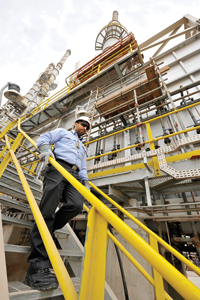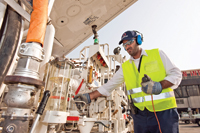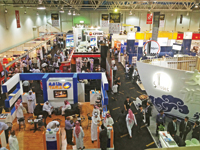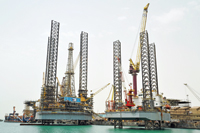

COOLING natural gas turns it into a liquid for easy shipment to energy-hungry towns and cities around the world. A giant new floating facility – the first of its kind – will make this possible at sea, unlocking vital energy offshore without the need to lay pipelines or build processing plants on land.
Some natural gas resources are located far from the people who need it to power their lives. Chilling natural gas to -162 deg C (-260 deg F) creates a liquid with 600 times less volume that can be shipped to customers around the world.
 |
A floating rig drilled the discovery wells of |
Until now, this liquefied natural gas (LNG) was produced in plants built on land. But Shell has developed new technology that will process the gas at sea, right where it is found, store it and transfer it for shipment.
“This is a groundbreaking development,” says Neil Gilmour, Shell general manager FLNG. “It will bring within reach new natural gas resources, currently considered too remote or expensive to tap,” he adds.
This new approach also provides a way to develop gas resources where laying undersea pipelines and ports would have too great an impact on the environment.
The first site to use this floating LNG (FLNG) facility will be Shell’s Prelude gas field, 200 km (124 miles) off Australia’s north-west coast. Prelude will produce enough natural gas to easily meet the equivalent of Hong Kong’s current needs.
HUGE BUT COMPACT
Once complete, the facility will have decks measuring 488 metres (1,601 ft) – the length of more than four soccer fields – and 74 m (243 ft) wide. Fully ballasted it will weigh roughly six times as much as the largest aircraft carrier. Despite its impressive proportions, the facility is only one-quarter the size of an equivalent plant on land.
“This has never been done before,” says Gilmour. “We had to find ways to adapt our technology for offshore,” he adds.
Engineers designed components that will stack vertically to save space. The cooling plant, for example, will be placed above the vast storage tanks. These have a capacity equivalent to around 175 Olympic swimming pools.
 |
Shell is the 100 per cent owner of the Prelude |
They also found a way to tap the cold of the ocean depths by pumping seawater to help cool the gas, avoiding the need for extra equipment on deck.
An assembly of eight 1-metre-diameter (3.3 ft) pipes will extend from the facility to about 150 m (492 ft) below the ocean’s surface. It will deliver around 50,000 cubic metres (1.8 million cubic ft) of cold seawater each hour.
STAYING FIRM
Shell’s FLNG facility is designed to operate and stay safely moored even in the most extreme weather conditions such as cyclones. This saves valuable production days that would otherwise be lost on disconnecting the facility and moving it off the field.
The design and sheer size of the facility will help it to withstand very high winds and giant waves. In addition, it will be secured in place by one of the largest mooring systems in the world. A 105-m (344 ft) high turret will run vertically through one end of the facility, anchored to the seabed by four groups of mooring lines. The turret allows the facility to rotate in the same spot with the force of the wind. “This pioneering technology has the potential to change the way we produce natural gas,” says Gilmour.







































































.jpg)
.jpg)







